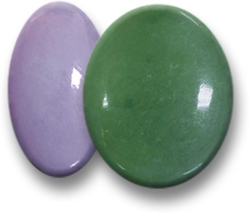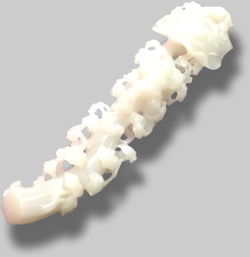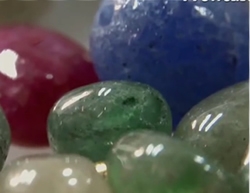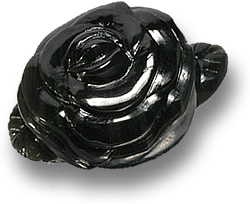|
|
Your Details
|
|
Your Details
|
Reviewed By Andreas Zabczyk
Don't Get Jaded by Hetian Jade Jewelry & Carvings
Colorful Jade Cabochons for Jewelry
In Asian countries, jade is considered to be one of the most valuable and precious commodities, particularly in China where its roots run deep. For the Chinese, the value of fine jade is higher than that of gold. Today, jade has become one of the most popular materials in the world, prized by those from both the Far East and the West, but, it has become increasingly rare over recent decades, since most jade mines have been overworked and supplies are dwindling due to sources becoming exhausted. For those who believe in the metaphysical powers of gems and crystals, jade is possibly one of the most historical and versatile gems when it comes to therapeutic and medicinal usage. In addition to healing powers, there are also countless superstitions associated with jade, with many beliefs known to date back over thousands of years. Because jade can be found in a wide variety of colors, its powers and abilities can vary depending on the actual color of the material worn or used. The energy (chi) of jade is also strongly dependent on how it is worn or where it has been placed within a room and which direction it is facing, according to the Chinese philosophy of feng shui. Chinese jade has been used extensively since the time of the Ming Dynasty (1364-1644). For most of history, jade was considered royal and was reserved only for the most noble of Chinese families. However nowadays, jade can be found in the homes of millions of Chinese families (and many other nations as well). It has become one of the most valued gems in the world and it can be shaped and polished into a variety of ornaments, ranging from jade jewelry to jade carvings of animals and sculptures. It is one of the few gemstone materials that is more commonly found carved rather than worked and cut into traditional gemstone jewelry shapes like round and oval cabochons. Although they are rare, jade cabochons can be sourced from most online gemstone suppliers. Typical ornamental jade carvings include small statues and decorative 'lucky' objects such as talismans, cameos and Buddha figurines. Jade is also one of the only gemstone materials that is commonly used to produce entire jewelry pieces, much like jewelry cast from pure gold, silver and various metal alloys. Most jade ornaments and carvings are made from a single piece of rough. Pure jade jewelry is often found as rings, bangles and anklets; and polished jade gemstones are popular for the making of men's cabochon rings, amulets and pendants, as well as for jewelry, such as charm bracelets, earrings and pins. 
Hetian Jade - Chinese Mutton-Fat Nephrite Jade Carving
Of the many different varieties of Chinese jade, Hetian jade is considered to be one of the most valuable, and also happens to be the most well-known of jade varieties. For most of time, Hetian jade was a term used only to refer to jade mined from the Kunlun Mountains of Xinjiang, in the Western Autonomous Region of China that borders Mongolia and Russia. The exquisite material mined from Xinjiang has been prized for thousands of years for its greasy luster and exceptionally strong color. The name 'Hetian' jade was assigned after the transliteration of the small oasis town of Hotan or 'Hetian', which is located in South-Western Xinjiang. Since it is also named Hotan (or Hetian), Hetian jade may sometimes be referred to as Hotan jade as well. Like many other gems named after localities, for example Paraiba tourmaline or amazonite, which was named after the Amazon River, the term 'Hetian' jade is no longer limited to jade mined from Hotan's Kunlun Mountains. As of more recent times, many jade gemstones mined from other localities, such as jade from Northern Xinjiang's Manas County are also being traded as Hetian jade. Even jade mined from Canada and South Korea can now be traded as Hetian jade, as long as its untreated, and the color and quality of nephrite is similar to that of the original material. According the standards of the Chinese gem and jewelry market, the classification and trading of jade mined from localities far from Hotan, is indeed acceptable. However, there are some materials being traded as 'Hetian' jade that are actually a mix of tremolite and jasper (nephrite is a fibrous variety of tremolite). Though it is normal for all gems to have impurities, for the most part, impurities should be minimal; they should be thought of as inclusions rather than part of the overall chemical composition. Gemstones that are equal parts jasper (quartz) and nephrite (tremolite) would technically be better classed as rocks; like maw-sit-sit, chloromelanite, omphacite jade and jade-albite, and they should be lower priced than pure nephrite and more importantly, should not be traded or advertised as pure 'Hetian jade'. True jade should be at least 95% pure and contain less than 5% impurities. Common inclusions found in jade include gemstones and minerals such as apatite, diopside, iron, olivine, pyrite, quartz and various other materials. 
Tumbled Chinese Nephrite Beads
All Chinese jade is often described as either hard or soft jade. Hetian jade is considered to be very tough and very hard. In fact, some Hetian material is so hard that it has been known to cut through glass. Hetian nephrite jade is divided into two main sub-varieties, which are 'mountain jade' and 'seed nephrite'. Of these Chinese jade types, 'seed-jade' is the most valuable form of Hetian jade. The 'mountain-jade' variety is still treasured by the Chinese jade connoisseurs, but because it has less tremolite and more impurities, it doesn't exhibit the same level of color quality, and lacks the greasy luster of the highly desired Hetian seed-jade. Seed-jade is almost pure tremolite, and like other forms of nephrite jade, it can occur in a variety of colors, including black, green, blue, yellow and white. In China, it is the white form of seed-jade that is the most sought-after form of Hetian nephrite jade. The Chinese refer to white seed-jade as 'mutton-fat' jade, and it can range from almost pure snow-white to slightly yellowish-white. White mutton-fat jade is the most valuable of all Chinese jade available, and the material from Hotan is considered to be the finest quality nephrite in the world. Hetian jade is often almost 99% pure tremolite, and when it comes to nephrite, the more tremolite it contains, the more valuable it is. The finest quality jade from Hetian has a buttery luster and creamy color like no other jade on earth. As with nearly every variety of gemstone, the diversity of colors found in Hetian jade is owed to the presence of impurities. In some cases, the impurities are favorable since they can cause rare colors like vivid pink, lavender and imperial green. There are no known naturally occurring tremolite deposits found in the Earth's crust, so all tremolite is the result of volcanic activity. After it has been brought up to the Earth's surface through volcanic eruptions, tremolite in its purest form is completely white and transparent. As it flows through volcanic lava, it mixes with other materials, which results in an increasing ratio of mineral content. Through the absorption of impurities, the white tremolite darkens in color, which also causes a reduction in transparency. This is why mutton-fat jade is so valuable, since it must remain very pure to retain its creamy white color. As the pure white mutton-fat jade picks up more impurities, it slowly takes on stronger green to yellowish colors. Green jade is a result of traces of chromium, while yellow comes from iron oxide content. 
Carved Rose Black Hotan Seed-Jade
Other forms of Chinese sourced jade include Xiu jade, which is highly valued by jade seekers. This type of Chinese jade is found mainly in Liaoning Province of Xiuyan County, and is known for its softness which allows it to be easily shaped or carved. Xiu jade is sometimes traded as 'serpentine jade' and often exhibits an attractive green color similar to that of Burmese jadeite, though it may also be found in white, yellow, dark green and even pink. Xiu jade ranges from semi-transparent to very near opaque. Lantian jade is another Chinese jade which is found in North Xian in Shaanxi Province. It is usually quite light in color, and yellow or green, and often exhibits a noticeable color zoning of light and dark areas. Even so, Lantian jade has become increasingly popular over recent years due to the lack of Hetian material available, and it is highly sought-after. Nanyang jade is also an interesting nephrite variety found in Nanyang County of Henan Province. It is much admired for its attractive and often unusual colors, including red, blue and very rarely, purple. This type of Chinese jade is also sometimes known as 'Dushan jade' which refers to the location of the jade mine; Dushan Hill. Unfortunately, high quality jade from Hotan is now almost never seen, and in the last decade, over-mining in Hotan and neighboring areas of China has resulted in a massive decrease in production, with many mines already facing depletion. In fact, hardly any new Hetian jade can be found today, because it is bought out locally before it can even make it to the international colored gem and jewelry markets. This may be one of the reasons why nephrite from other regions is now being accepted as 'Hetian' jade, including fine quality nephrite from other areas of China, as well as far-away countries, including Australia, Canada, New Zealand, Russia, South Korea and the USA. |
